
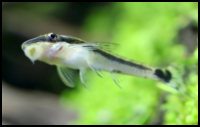
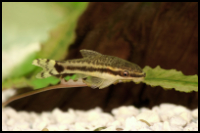
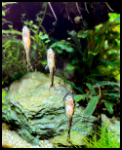
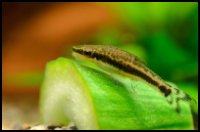
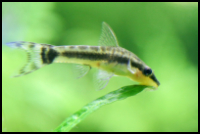
Quick Care Details (Table)
| Livestock Characteristics | Value |
|---|---|
| Care Level | Moderate |
| Temperament | Peaceful |
| Diet | Herbivore |
| Maximum Size | 2 inches (5 centimeters) |
| Minimum Tank Size | 10 gallons |
| Plant Safe | Yes |
| Temperature Range | 72°F to 78°F (22°C to 26°C) |
| PH Range | 6.5 to 7.5 |
| KH Range | 3-8 dKH |
| GH Range | 3-10 dGH |
Species Specific Categories
Helpful Video
Care Details
- Aquascape: Incorporating live plants like Java moss, Java fern, and Anubias provides grazing surfaces for your Otos and contributes to the tank's aesthetic. Driftwood and smooth rocks not only enhance the environment but also offer hiding spots for your little algae eaters.
- Substrate: While sand or fine gravel is better, please make sure it's well-rinsed in freshwater before placing it in the tank to prevent cloudiness.
- Disease Prevention: Quarantine new Otocinculus fish before introducing them to the main tank, maintain stable water parameters, and avoid overcrowding to reduce stress.
- Filtration: A sponge or canister filter provides adequate filtration as long as you also offer strong currents for your otocinclus.
- Lighting: Keeping Otocinclus Opt for LED aquarium lights with adjustable settings to mimic a natural day-night cycle, providing about 8-10 hours of light daily.
- Water Flow: Otos prefer strong water flow is essential as these fish thrive in moving river waters.
- Hardiness: While Otocinclus are relatively hardy, sudden changes in water conditions can stress them.
- Acclimation: Gradual acclimation over 30-60 minutes by floating the bag in the tank helps them adjust to new water parameters.
- Expected Lifespan: Healthy Otocinclus catfish with proper care, can sometimes live up to 5-6 years.
- Special Requirements: Ensure a stable environment with consistent algae growth; offer a varied diet to supplement their algae consumption.
document.getElementById("care-details-next-tab").addEventListener("click", function() {
document.getElementById("temperament-tab").click();
});
Temperament and Behavior
- Behavior: Otocinclus are peaceful and spend most of their time grazing on algae or perching on surfaces.
- Breeding: Breeding in captivity is challenging due to specific conditions needed, such as a separate breeding tank with soft, acidic water and suitable surfaces for egg deposition.
- Aggression: They are non-aggressive but might be intimidated by larger or more active tankmates.
- Tankmates Compatibility: Ideal tankmates include small tetras, rasboras, dwarf cichlids, or peaceful catfish species like Corydoras.
- Activity Level: Healthy Otos are moderately active during feeding times but otherwise tend to perch on surfaces or graze slowly.
- Schooling or Shoaling Behavior: They feel more secure and exhibit natural behaviors when kept in groups of at least 6 individuals.
- Plant Compatibility: Safe with most aquarium plants; their herbivorous nature doesn't typically lead to plant destruction.
document.getElementById("temperament-next-tab").addEventListener("click", function() {
document.getElementById("diet-tab").click();
});
document.getElementById("temperament-previous-tab").addEventListener("click", function() {
document.getElementById("care-details-tab").click();
});
Diet and Nutrition
- Dry Foods: These catfish would eat sinking algae wafers or pellets designed for herbivores can supplement their diet.
- Frozen Foods: Offer occasionally, as they may accept frozen foods like brine shrimp or bloodworms.
- Live Foods: Otos rarely accepted in captivity; they primarily feed on algae.
- Vegetables: Your Oto will enjoy a blanched vegetable. You can offer fresh veggies like zucchini, cucumber, or blanched spinach for variety.
- Algae: Otocinclus catfish is the main source of sustenance; ensure a consistent supply of natural algae or algae-based foods.
- Feeding Schedule: Otos spread small portions throughout the day to mimic their natural grazing habits.
- Supplemental Foods: Use algae-based supplements or blanched vegetables to diversify their diet.
document.getElementById("diet-previous-tab").addEventListener("click", function() {
document.getElementById("temperament-tab").click();
});
document.getElementById("diet-next-tab").addEventListener("click", function() {
document.getElementById("tank-parameters-tab").click();
});
Tank Parameters
- Tank size: While a 10-gallon tank can accommodate a small group of Otos, larger tanks offer more stability and space for multiple Otocinclus.
- Tank Length and Measurements: Longer tanks provide more surface area for grazing; a 20-gallon long tank (30 inches or more) is ideal.
- Water Temperature: Aim for a consistent tank water temperature within the range of 72°F to 78°F (22°C to 26°C) for your Oto.
- pH: Maintain your freshwater at slightly acidic to neutral pH level between 6.5 to 7.5 inorder to best care for your Oto.
- KH: Keep the carbonate hardness between 3 to 8 to maintain tank stability for these Otocinculus catfish.
- GH: Otos prefers General hardness should range between 3 to 10 to support their well-being.
- Nitrate (NO3) levels: Otos need to keep nitrate levels low through regular water changes; aim for levels below 20 ppm. Regular testing is crucial to monitor water quality.
document.getElementById("tank-parameters-previous-tab").addEventListener("click", function() {
document.getElementById("diet-tab").click();
});
History, Popularity, History and Species Variety Details
The History, Popularity and Natural Habitat
History
The Otocinclus, often affectionately called "Otos" by aquarists, have a fascinating history. They were initially discovered in South America, primarily inhabiting the rivers and streams of the Amazon basin. These petite algae-eaters gained attention among aquarists due to their ability to control algae growth in tanks while remaining peaceful community fish. Their introduction to the aquarium trade happened several decades ago, gradually gaining popularity as a reliable algae-eating species among hobbyists worldwide.
Popularity
Otocinclus has earned its popularity for several reasons. Their diminutive size and peaceful nature make them excellent additions to community tanks, significantly smaller setups. Aquarists appreciate them for their voracious appetite for algae, helping to maintain tanks clean and balanced. Additionally, their charming behavior and sociable nature within groups have endeared them to many hobbyists. Their hardiness, relatively easy care requirements, and low aggression levels further contribute to their popularity among both beginners and experienced aquarists alike.
Natural Habitat
These delightful fish hail from the diverse freshwater habitats of South America, particularly the Amazon River basin and its tributaries. In the wild, Otocinclus thrive in slow-moving waters, including streams and small rivers with dense vegetation. They prefer areas with ample algae growth on rocks and plant surfaces, where they graze almost constantly. Their natural habitat's slow-moving waters and abundant plant life have influenced their behaviors and dietary preferences in captivity.
Back to topSimilar and Variations of the Species
- Otocinclus Affinis: A closely related species to the Otocinclus vittatus, often mistaken for each other due to their similar appearances and behaviors. They share comparable care requirements.
- Otocinclus Macrospilus: Another species resembling the Otocinclus vittatus, known for its attractive spotted patterns. Like the vittatus, it prefers similar water conditions and diet.
- Otocinclus Vestitus: This variation is distinguishable by its striped appearance and is sought after by hobbyists for its unique markings. Its care and tank requirements align closely with other Otocinclus species.
- Otocinclus Cocama: Also known as the Zebra otocinculus because of their unique zebra-looking pattern across their body.
These variations share many characteristics with the Otocinclus vittatus, including their algae-eating habits, peaceful demeanor, and preference for similar tank conditions. Aquarists often find these variations appealing due to their aesthetic differences while enjoying the same benefits of having Otocinclus in their aquariums.
Back to topPersonal Perspective
I love these catfish for any nano tank! They stay relatively small and are not extremely active swimmers. I find it to be more than enough for them to be in a 10-gallon tank; the only issue for them with having a small tank is being able to maintain good water quality. So, as long as you can keep up on your water changes and not overfeed your other community fish, I think you will really enjoy them.
Always be sure to keep them in at least groups of three since they do shoal. When they are feeding actively, they will go out on their own, but I notice whenever they are just chilling and relaxing, they are always close together, either under the same rock or all pressed against the glass together.
Another limiting factor when keeping them in a small tank is the amount of natural algae you can produce for them. They will probably eat everything you have and slowly starve out if you don't feed them vegetables or algae wafers. I would recommend getting them used to algae wafers as soon as you get them into your tank because it might take some time for them to realize that it is food. If it takes them a long time to realize, at least they might still have natural algae sources if you start training from the start.
I would also recommend having moderate water flow if possible. It isn't an end game if you have minimal water flow, but they are found in active freshwater rivers in their natural habitat, and we should always try to recreate their natural homes.
Frequently Asked Questions
What size tank do common Otocinclus need?
Otocinclus thrive best in tanks of at least 10 gallons. However, considering their social nature, providing more space in a larger tank, like a 20-gallon long, allows them to flourish and exhibit natural behaviors.
Do they eat algae exclusively?
While they adore algae, it shouldn't be their sole diet. They relish blanched vegetables like zucchini and cucumber, algae wafers, and occasionally, small portions of live or frozen foods like bloodworms or brine shrimp.
Are they suitable for a beginner's aquarium?
Absolutely! They're a fantastic choice for beginners due to their peaceful nature and relatively undemanding care requirements. Just ensure stable water conditions and a healthy algae supply.
Can Otocinclus survive in a tank without algae?
They can, but it's not recommended. Algae form a significant part of their diet, and without it, they might not get the necessary nutrients. It's crucial to maintain a steady supply of algae or algae-based foods.
How many Otocinclus should I keep together?
Otocinclus are social creatures and thrive in groups of at least 4 to 6 individuals. Keeping them in smaller numbers might cause stress, affecting their health.
Will Otocinclus vittatus eat all types of algae?
They have preferences! They particularly enjoy soft green algae types and diatoms. However, they may not eat tougher forms like black brush algae.
Can healthy otos tolerate poor water quality?
Despite being hardy, they're sensitive to sudden changes in water parameters. Consistently good water quality is crucial for their well-being. Regular water changes and maintenance are essential.
Do these fish breed easily in home aquariums?
Breeding them in captivity is challenging due to specific requirements like separate breeding tanks with soft, acidic water and proper breeding triggers, making successful breeding rare.
Are they compatible with all fish species?
While generally peaceful, avoid housing them with aggressive or larger fish that might intimidate or outcompete them for food. Choose tankmates that share their peaceful demeanor.
Do Otos need special care during acclimation?
Yes, they're sensitive during acclimation. Gradually introduce them to the tank water over 30-60 minutes to minimize stress and ensure a smooth transition.

